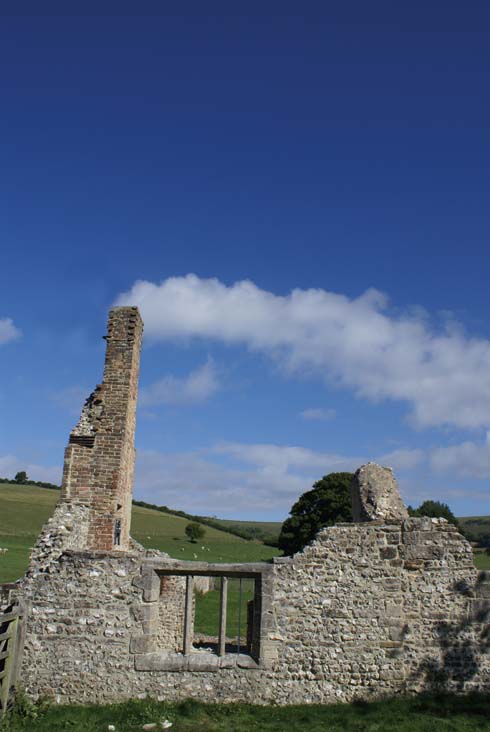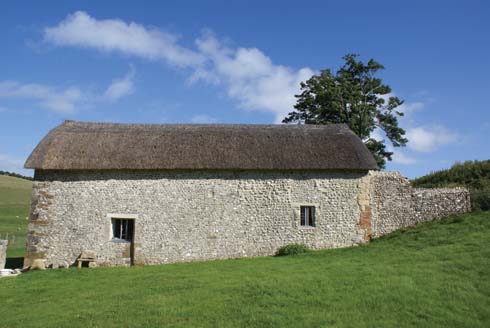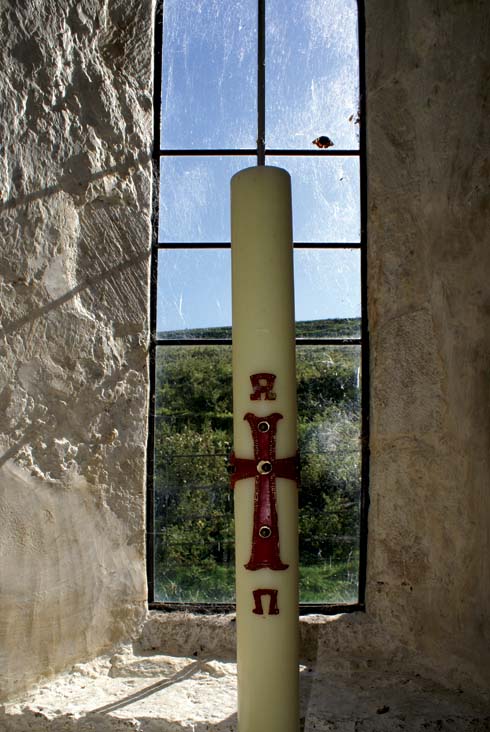The lost buildings of Lyscombe
Jo Draper traces the history of a tucked-away village, its chapel and one remaining, ruined cottage
Published in October ’13

The chapel and ruined cottage as seen from the entrance to the field which used to be the village of Lyscombe
The wide and high band of chalk across the middle and north of Dorset still creates an austere and rather empty landscape, with villages only in the valleys. The fine turf of these downlands
was created and maintained by thousands of sheep: until artificial fertilisers were created in the 19th century, arable was not possible on these chalk hills. The Downs had no hedges, so were just huge and open. Travellers mostly disliked the area: Cooke’s Dorsetshire of 1836 thought ‘the appearance of the chalky surface is in general smooth and verdant, but remarkable in its deficiency of hedges, timber and young plantations, which of course destroys every pretension to picturesque beauty’.
This big landscape has lots of archaeology. In the 1790s George Lipscomb, a curious traveller, traced Bokerley Dyke right on the north of Dorset chalk for at least two miles. He ‘enquired of
some shepherds, who were tending their flocks on the Downs, where this bank terminated – one of them said “a terrible ways off”. Upon asking how far that might be, we were answered. “they zays it goes into Vrance, but never zeed it myself”.’ Posh visitors asking silly questions must have amused the shepherds, and given them chances for teases, but this exchange does give a feeling of the scale of the chalk. One of the valleys in this chalkland (Lyscombe) preserves its old remoteness, and has interesting old buildings.
Lyscombe’ s very name suggests remoteness, a lost coombe. The tiny settlement in its huge empty valley fits the name well. The name Lyscombe is recorded from Saxon times and means reeds (lisc) and valley (coombe). The huge coombe is still empty apart from the tiny hamlet, and reeds still grow in boggy bits by the small stream. There is no road through the valley, so all visitors must walk. Until the 1880s access was even more difficult, with only a rough track (now a footpath) leading to the hamlet. Lyscombe was sold in 1880 (along with 1,320 acres of Plush) and the sale map shows that there were only three buildings in the hamlet then – the late medieval barn, and across the river the cottage and chapel. Lyscombe was an out-farm, with just the barn and cottages. The land was farmed as part of a much larger area, and the farmer lived elsewhere. Indeed in 1880 Lyscombe must have had even fewer buildings than it did in medieval times. By 1900 a new access road (the current one) had been built, along with a big farmhouse and more farm buildings.
Today there is a car park at the top of the road built in the 1890s, making it easy to walk in the area. In the bottom of the valley is first the large farmhouse of the 1880s, then a biggish group of farm buildings incorporating the remains of the late medieval barn. Neat flints walls are the clearest bits. Until the Second World War this barn was in reasonable condition, still preserving its original 16th century roof. The barn was very well built, with good stone and fine flintwork. Photographs of 1948 show the roof giving way, and soon it all collapsed. Only parts of the walls survive today with a new roof.
Round the corner and across the stream (with its pool for sheep washing) things are different: two buildings only – the ruined cottage and the restored tiny chapel. These two ancient buildings were still whole, thatched and in use in 1950: the second half of the twentieth century was very bad for them. In 1880 these (and the barn) were the only buildings at Lyscombe, and presumably the cottage was inhabited by farm labourers. Cottage and chapel are much the same size, but the chapel was protected by a sort of Dutch barn being built over it in about 1958. This roof collapsed in the 1990s, and finally in 2007 the chapel was completely restored with a new thatched roof and much work inside. The little chapel has a 12th century chancel and a later medieval nave, both tiny. Many churches started off like this, without a tower, no aisles, and all on a very small scale. Nearly all the others have been enlarged and improved. Lyscombe has not.
Outside the chapel looks rather like a blank cottage, with very few windows. Inside is different – clearly medieval with a narrow Norman chancel arch, whose supporting pillars were rather mutilated when the chapel was turned into a cottage, probably in the 17th century. In 1903 antiquarian visitors found the nave ‘now used as a bakehouse (there is a large open grate, oven, and chimney in the centre), and the chancel is used as a log-house. A flight of stone stairs leads to bedrooms over the bakehouse and loghouse’ and all inside was whitewashed. These visitors regretted the loss of a ‘beautiful niche, eight feet high, with a crocketed canopy’ which had been in the corner of the chancel in the mid-19th century. Crocketing means that the niche was decorated all up the edges. It was medieval.
The antiquarians of 1903 found the cottage inhabited by a farm labourer, and they admired ‘a great deal of old oakwork’ inside. Some of this still survived in 1948. The cottage was a really early one, dating from the 16th and 17th centuries. The cottage suffered worse than the chapel because no protecting roof was erected: the owners have ‘stabilised’ it as a ‘romantic ruin’.
What was thought to be the first service for 500 years was held in the chapel in 2007, with hymns and a picnic afterwards.
Chapel, cottage and barn are the main buildings of a classic medieval hamlet, not a village. Proper villages have churches: this building was a chapel, dependent on another church. Usually
this meant that burials had to take place at the head church, but other services could be held at the chapel, saving a lot of travelling. Originally Lyscombe was dependent on Milton Abbas, five miles away. The closest church is Cheselborne, only two miles away. Lyscombe is interesting as a rare survival of an isolated hamlet, and also unusual because the ancient chapel and cottage suffered so badly in the second half of the 20th century.

A moss-covered stone pulpit and simple wooden cross are, a table apart, all that furnishes the chapel
The hamlet is well worth visiting for its own sake, but it also gives access to high footpaths around the coombe, and many paths on the chalk Downs running east-west. Lots of archaeology – ancient field systems, cross-ridge dykes and even an unfinished hillfort at Nettlecombe Tout.





